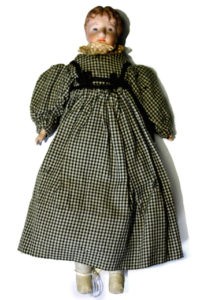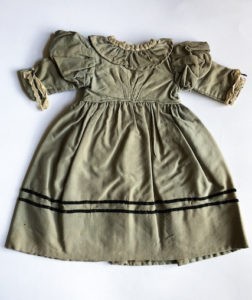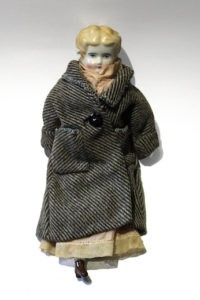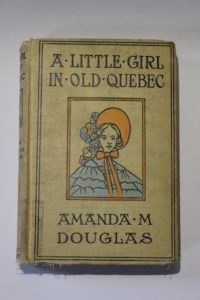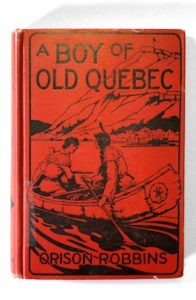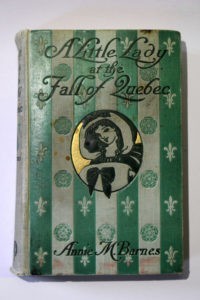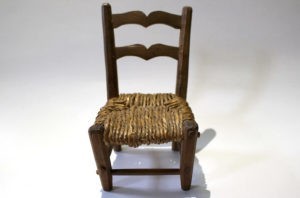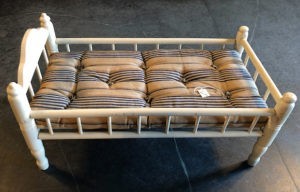Most of the items in the Stephens Collection were viewed as toys for girls. While toy tea sets and miniature furniture allowed young girls to play house, dolls were intended to prepare them for motherhood. During the late 19th century, toys for little boys typically included soldiers, sailors, animals, and vehicles, items that are largely absent from this collection.
The Stephens Collection contains two dolls from the turn of the 20th century. Around this time, many dolls were stitched by hand; their bodies were made of cloth stuffed with straw, and their heads, hands, and feet made out of wood, plaster, wax, or porcelain. Stores sold doll heads to graft onto homemade creations. This is how the two dolls in the collection were made. One of the doll heads was imported from Germany, which was an important centre for toy making until the early 20th century. The poorest children typically played with dolls made from rags or other materials found around the home.
The doll with the tweed coat is named “Elsie.” She belonged to Margaret Robinson, whose father, Alfred W. Robinson, was one of the managers of the Johnson Asbestos Company mine in Thetford Mines, Quebec.
-
DOLL
Late 19th-early 20th century, unknown
Ceramic, leather, wool, cotton, lace, and metal
Stephens Collection 2004-326
37.5 x 14 x 7 cm
-
DOLL’S DRESS
Late 19th century, unknown
Cotton, lace, velvet, and mother-of-pearl
Belonged to the Rowand family
Stephens Collection 2004-312
40 x 41 x 1.5 cm
-
DOLL “ELSIE ROBINSON”
c. 1899, Germany and Canada
Ceramic, wool, lace, cotton, and metal
Belonged to Margaret Robinson
Stephens Collection 2004-193
26 x 17 x 5 cm
-
Amanda M. Douglas, A Little Girl in Old Quebec,
New York:
A. L. Burt Company, 1906.
LHSQ Library, Special Collections 971.01 D734
-
Orison Robbins, A Boy of Old Quebec: A Story of Adventure in Woods and Indian Towns, Boston: Lothrop, Lee & Shepard Co., 1926.
LHSQ Library, Special Collections 813.4 R635
-
Annie M. Barnes, A Little Lady at the Fall of Quebec,
Philadelphia: Penn Publishing Company, 1909.
LHSQ Library, Special Collections 819.22 B261
-
DOLL’S HABITANT CHAIR
c. 1916, Quebec City
Wood and wicker
Stephens Collection 2004-194
16.7 x 10.5 x 12 cm
-
DOLL’S BED
Late 19th- early 20th century, unknown
Wood, fabric, and thread
Stephens Collection 2004-324 and 2004-325
29.2 x 51.8 x 25.6 cm
Excerpts from writings by Mary Hilda Freeland Stephens:
“Elsie belonged to Margaret Robinson whose grandfather, George, was born in Sunderland, England, in 1833. In 1845 the family moved to Canada and lived in Bytown (Ottawa). … Elsie, who sits on the chair in The Collection, was given to me by Margaret’s sisters, Ruth and Elizabeth (Lil). Elsie is doing very well for a 100-year-old.” (Mary Hilda Freeland Stephens, My Quebec Collection, 10)
“Another place I loved to go with Grandma was the Montcalm Market where D’Youville Square is now. In My Quebec Collection there is a little rush-bottomed doll’s chair which was bought there for 25 cents. In the large stone market building were the Butcher’s shop, fruits stalls and fish counters. I loved scuffing through the sawdust that always was on the floor.” (Mary Hilda Freeland Stephens, Remembering a Quebec Childhood, 6)
“The Love children played in The Manse yard: mother and her sister took their toys out under ‘The Four Trees’ and played house. So did I, playing with the same doll’s bed which I still have.” (Mary Hilda Freeland Stephens, Remembering a Quebec Childhood, 2)
